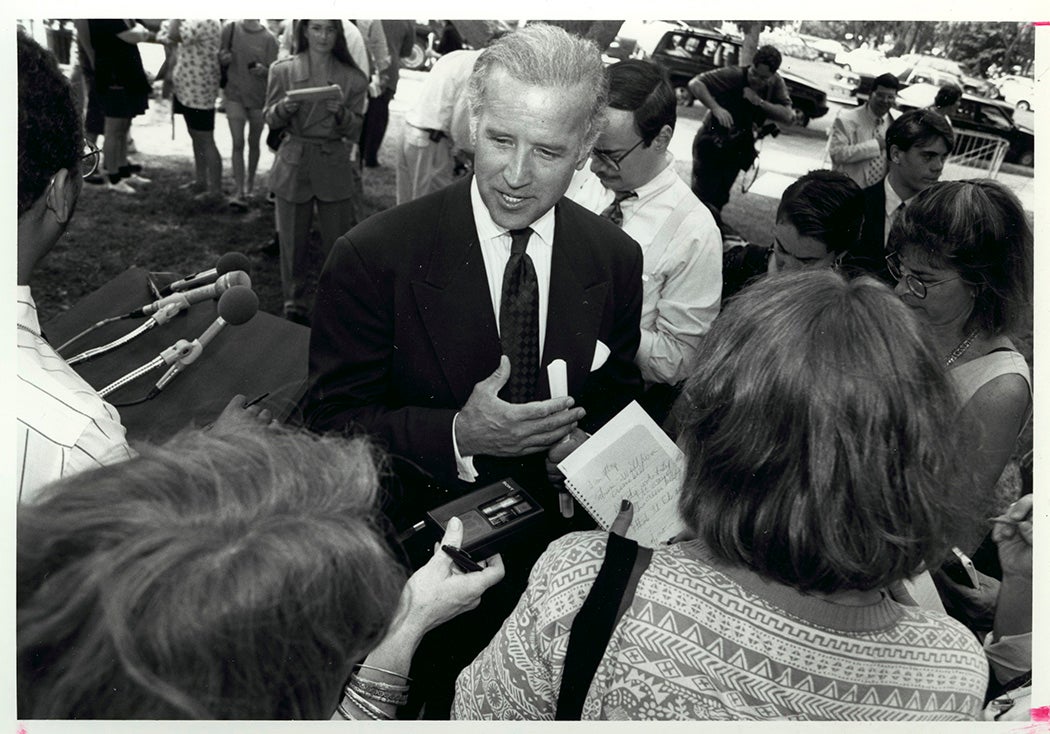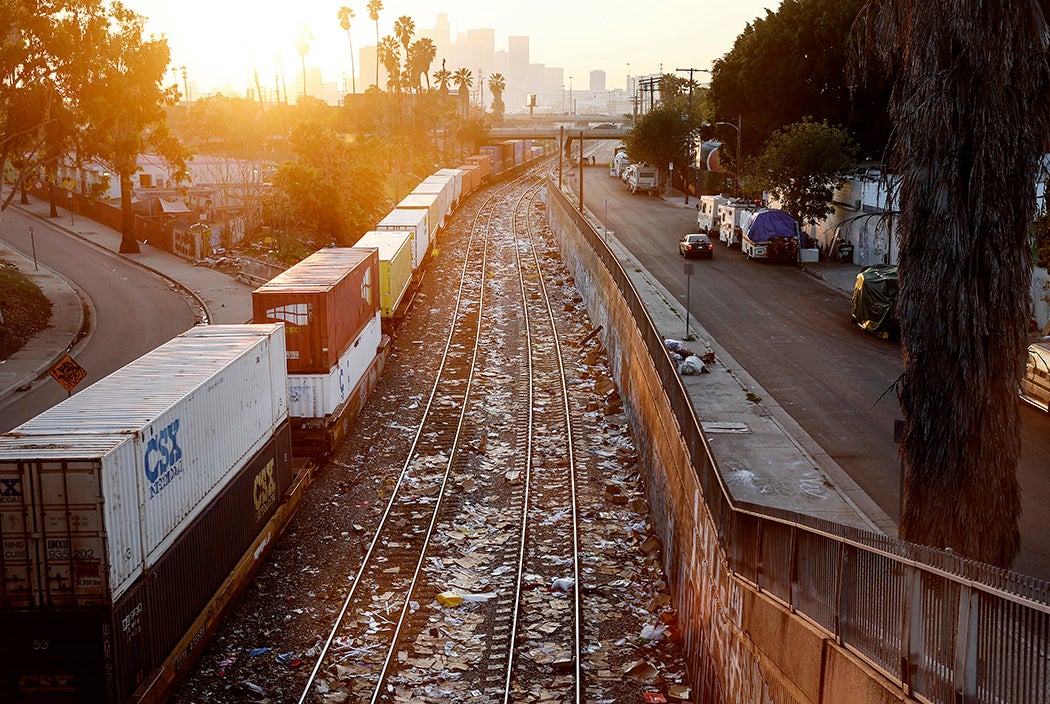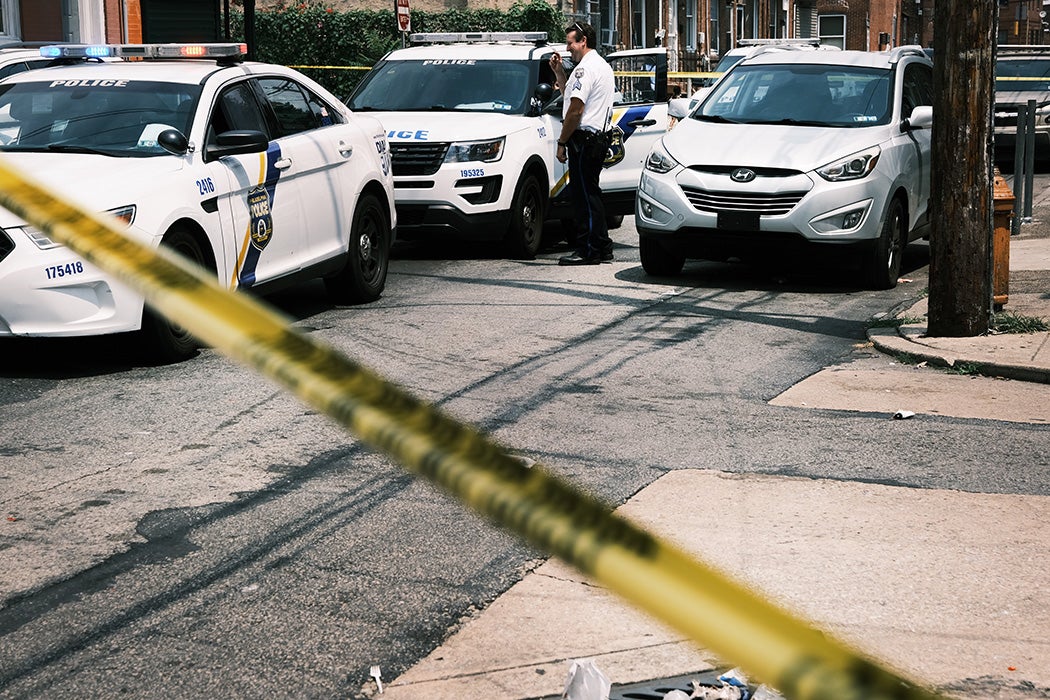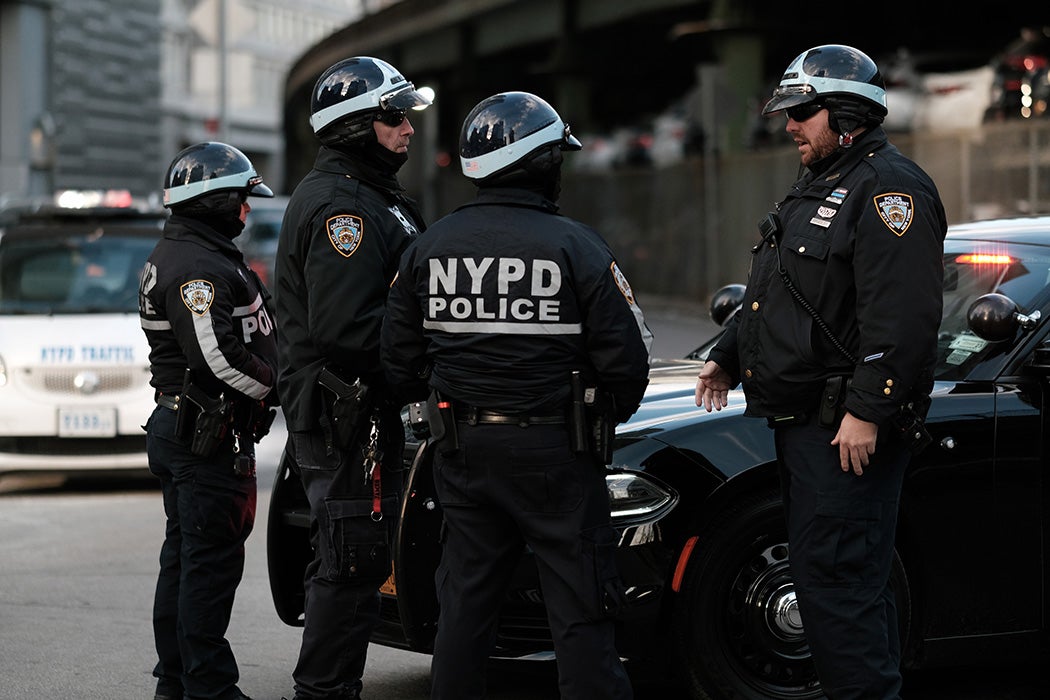Organized retail theft, train robberies, and murders! According to news headlines, a crime wave is sweeping the US. Yet as JSTOR Daily has reported before, sometimes crime waves are little more than moral panics. Other times, media coverage does reflect actual increases in crime. To understand the difference, each allegation needs to be carefully dissected and analyzed.
The first documented crime wave moral panic was in 1744 London. In many ways, that panic resembled the panic about crime waves today. Historian Richard Ward identified phases of the 1744 panic and a pattern of public reaction that has become formulaic: Initial media attention garners further media attention, inspiring broad concern in the public, which leads to more crime getting reported to the police, which leads to a further perception of increased crime, and a response of increased punishment and control.
Weekly Newsletter
This phenomenon often occurs after reform measures are implemented, no matter how moderate. In Victorian Britain, for example, reformers sought to diminish the use of public execution and floggings. Temporarily, they succeeded. Though the actual crime rate didn’t budge afterwards, constant coverage from the incipient mass media industry led people to believe it had increased, and that the reduction in executions and floggings were to blame. In response, new laws restored the broad use of corporal punishment.
Sociologist Vincent F. Sacco writes that the media misshape our conceptions of crime when coverage is divorced from actual shifts in the crime rate. According to Sacco, “News reports also distort the relationship between crime and legal control. In the news, the police appear to be more effective in apprehending offenders than police data would suggest that they are.” Sacco frames this as a natural extension of news rooms’ reliance on trusted sources, frequently interpreted to mean the police. This objective framing of crime and punishment belies far more subjective elements of law and punishment.
Crime waves and their ensuing mythologies are often used to justify stiffer and stiffer punishments. Today, special interest groups such as Buy Safe America Coalition are seeking amendments to the criminal code to allow for punitive punishments for theft.
What Deters Crime?
Even the federal government has illuminated the error of focusing on the severity of punishment. A 2016 report from the US Department of Justice’s National Institute of Justice offers five facts about crime deterrence. They’re worth addressing in their entirety, as they run counter to most political campaign policy positions on crime:
- The certainty of being caught is a vastly more powerful deterrent than the punishment.
Research shows clearly that the chance of being caught is a vastly more effective deterrent than even draconian punishment.
- Sending an individual convicted of a crime to prison isn’t a very effective way to deter crime.
Prisons are good for punishing criminals and keeping them off the street, but prison sentences (particularly long sentences) are unlikely to deter future crime. Prisons actually may have the opposite effect: Inmates learn more effective crime strategies from each other, and time spent in prison may desensitize many to the threat of future imprisonment.
- Police deter crime by increasing the perception that criminals will be caught and punished.
…
- Increasing the severity of punishment does little to deter crime.
Laws and policies designed to deter crime by focusing mainly on increasing the severity of punishment are ineffective partly because criminals know little about the sanctions for specific crimes.
More severe punishments do not “chasten” individuals convicted of crimes, and prisons may exacerbate recidivism.
- There is no proof that the death penalty deters criminals.
…
The most effective crime deterrent is the certainty by which someone will be caught and convicted. Increasing the abstract potential length of imprisonment has not been shown to deter crime. And yet, in the face of crime waves both real and imagined, the policy response is often to increase sentence lengths.

The National Institute of Justice’s report draws heavily from Daniel Nagin’s article “Deterrence in the Twenty-First Century” in Crime and Justice. Merely synthesized in the federal report, Nagin’s full piece plumbs the depths of crime control policy and offers glaring insight into approaches that are both commonplace and misguided.
An incarceration-based sanction policy that reduces crime solely by incapacitation will necessarily increase the rate of imprisonment. In contrast, if the crime control policy also prevents crime by deterrence, it may be possible to reduce both imprisonment and crime; successful prevention by any mechanism, whether by deterrence or otherwise, has the virtue of averting not only crime but also the punishment of perpetrators.
Nagin concludes that, “…it is clear that lengthy prison sentences cannot be justified on a deterrence-based, crime prevention basis.” For crime prevention, he asserts that police presence can increase the perception that there is a certainty of apprehension.
According to the Vera Institute of Justice, 66.75% of all serious crime went unsolved in 2018. For the 33.25% who were caught, they often faced longer sentences than they would have in other wealthy democratic nations. The United States has the highest rate of incarceration in the world, much higher than even dictatorships and authoritarian regimes.
Although an increase in our clearance rate—the rate by which serious crimes are solved—would be a more effective crime deterrent, that proves elusive. Most importantly, it is beyond the direct control of lawmakers, who in turn focus narrowly on what is within their purview: sentence length. Political campaigns are built around anxieties over crime and safety, with promises of increasingly harsh sentences commonplace. Politicians, for one, seem undeterred by data that contradict their claims that longer sentences increase public safety.
Drugs
Selling a $20 bag of drugs has long been a crime that warranted imprisonment. But in the face of rising outrage over our overdose crisis, this crime has been increasingly rebranded as homicide since 2014. Though the act itself hasn’t shifted—selling small amounts of drugs—lawmakers were able to stiffen punishments by considering the outcome, however unintended. Drug delivery resulting in death laws, like the ones used to prosecute the men who sold Michael K. Williams the dose off of which he overdosed, are being adopted by more states nationwide.
While data are difficult to assess because they are disaggregated and by county, out of the more than 100,000 fatal overdose deaths annually, only a tiny fraction are charged as homicides, likely less than 1%. Despite the abhorrent death count, it remains true that most people who use drugs do not die, meaning there can be little certainty that an overdose would even occur, much less be prosecuted. Longer and longer sentences are being advised for people who sell drugs if a death occurs, although sentence length is not a substantive crime deterrent. Meanwhile, drug overdose rates reach historic highs. The impulse to reach for punitive solutions, rather than preventive, appears deeply engrained.
Stores
Many state legislatures have introduced new laws to create harsher penalties for shoplifting, often at the behest of lobbyists representing retailers. Though some proposals do address the certainty of conviction that the National Institute of Justice says is the most effective crime deterrent, mostly they’re about increasing the potential sentence length. This is done by aggregating the value of the person’s thefts across time, which is able to trigger a felony. Such laws have been enacted or proposed from Florida to California.

In California, the trade groups lobbying for the law cited theft dollar value estimates so inflated it prompted a thorough debunking by the LA Times. Shrink, industry jargon for inventory loss whether by paperwork errors, shoplifting, fraud, or employee theft, increased 0.2% in from 2015 to 2020 according to the National Retail Federation. Though data are notoriously splintered, best estimates put the actual profit losses stemming from organized retail theft at around 0.07%. Disproportionality is a hallmark of a moral panic.
In October, Walgreens closed five stores in San Francisco, citing retail theft. Three months later, Walgreens and CVS announced nationwide closures of some of their stories but cited the Omicron variant and staffing shortages. The moral panic of the moment makes a convenient scapegoat, though reality is often far more complex.
Amanda Mull’s feature “The Great Shoplifting Freak-Out” in The Atlantic extricates reality from panic, by focusing on how crime stories conflate smash-and-grabs—which are felonies—with misdemeanor theft. What constitutes “organized” retail theft is never clearly defined by the police or public relations officers who refer to it.
Though the special interest groups use egregious examples of truly organized retail theft or violent burglaries to support the creation and enforcement of their laws, in application it would appear they are used for mundane shoplifting. As Mull states, brick-and-mortar retailers who long operated on a narrow margin have felt the crunch from online shopping. It’s unclear—because it’s kept an industry secret—to what degree or if shoplifting has actually increased, but the impact of it is being felt on a tighter and tighter budget.
Trains
Train robberies may sound like something out of the Wild Wild West, but according to media coverage, they’re frequently occurring in present-day Los Angeles, California. Union Pacific, which owns operates its own police force, has released statements about increased theft along the tracks.

Upon going to the trainyard to investigate the claims, an LA Times reporter spoke with a man who seemed to be engaged in simple theft. Yet Union Pacific’s Director of Public Affairs, Adrian Guerrero, said that, “about 90 cargo containers a day are compromised, sometimes by an organized group that has halted trains and recruited people living on the street to ransack the containers.” Guerrero’s claims range from unsubstantiated to unlikely.
A different LA Times article hints at how the situation became so dire. “Under federal law, Union Pacific and other railroad companies can employ their own police force accredited by the state to protect tracks. Former employees and police say budgetary issues have slashed the ranks of the company’s force, leaving as few as half a dozen in the region.” Public outcry about purported increases in thefts often leads to an increased police presence, thereby shifting the cost burden of whose job it is to provide security from the corporation to the city. George Gascón, the progressive district attorney in Los Angeles County, is often blamed by law enforcement officers and corporate spokespeople for the city’s crime.
Violent Crime Conflation
The conflation of property crime with violent crime—theft with robbery—is a facet of crime wave stories. In Portland, a local media outlet ran the headline, “Survey: Over 60% of Portland small businesses grapple with break-ins.” But in the body of the article, the 60% of respondents had experienced either a break-in or vandalism. Burglary is a felony sometimes subjected to mandatory minimum prison sentences in the state, graffiti is not. They are two very distinct crimes, but their conflation gives the appearance of the proliferation of violent crime.
While exact verbiage varies by state, robbery implies the taking of property by force. Theft is strictly property crime, the taking of a thing, while robbery implies a human victim. According to available data, property crime is flat or down in most US cities, including San Francisco despite the moral panic. (Note: 2020 was a statistical anomaly, so while property crime may seem elevated year-over-year, numbers remain below their 2019 norms.)
During crime’s lowest points over the past decade, there was a mismatch of public perception. With crime stories making up the lion’s share of media coverage, the American people were continuously convinced that crime was increasing. For years, this was false. Crime had been at historic lows and in decline.
Murder
Now, homicides have increased steeply, and not just in the United States. In the US in 2020, homicides rose nearly 30% over the previous year. While that increase wasn’t sustained through 2021, homicides remain elevated over recent years. They are still well below the peaks of the early 90s.
The risk of being murdered is not shared equally across the population. This has long been a recognized problem, with Ruth Peterson and Lauren Krivo addressing the matter in their piece “Racial Segregation and Black Urban Homicide.” Then, as now, Black Americans were vastly more likely to be murdered than their white counterparts.

Yet crime stories rarely convey circumstances or relationships, often giving the impression that violent crime is random. One in 1000 Black Portlanders were murdered in the year from June 2020 to June 2021. Black people represent 5.8% of the city’s population, but 41% of its homicide victims. While the disparity is less stark in other major cities, it persists nationwide.
While crime stories are often one-dimensional, recited in rote terms of victim and perpetrators, research asserts that the bright-line distinction between each category belies a broader complexity. Victims and perpetrators are often of the same demographic, and a mix of chance and circumstance dictate on which side of the dichotomy they fall on a given day.
Suicides and drug overdoses dwarf homicides annually, and both receive less media attention. There is something inherent to crime and its coverage in the media that spawns fear in a way that other more statistically common injuries do not.
If that fear can translate into effective public policy decisions is to be determined. Historically, it has translated into increased sentence lengths but not higher case clearances. While some elements of the US being under a crime wave may be factual, others are reliant on exaggerations, redefinitions, or outright inventions. Extricating truth from media panic is a challenge of the times, and media literacy in the US is infamously low.
Crime Wave or Moral Panic?
The politicization of crime is nothing new to the US. It was most apparent during the tough-on-crime era of the late 1980s and early 1990s. While the movement enjoyed broad bipartisan support, there was concerted (conservative) opposition. As captured in a 1992 issue of Prison Legal News, 350 public figures including corrections officials across 20 states pleaded for humanity. “In this election year, we urge all candidates to refrain from politicizing crime and punishment policy. Appeals to base human instincts and demagoguery will ultimately make the problem worse.” Shortly after that, a spate of even tougher crime bills passed. Apparently, their pleas had fallen on deaf ears. The perception and reality of crime during the era shaped public policy.
“Moral panics require both cultural imagery that can be built into a sense of threat and politicians able to attract voters by using that threat,” write Nancy Cauthen and James Jasper in Sociological Forum. “Cultural constructions such as moral panics are also political strategy.” The difficulty in parsing reality from sensational coverage, “fake news,” and inflammatory campaign statements is casting ever more implications on US democracy. Political toxicity has reached new heights. Public policy maneuvers based on falsehoods will be inherently ineffective.
The conjuring of a crime wave and the ability to blame it—whether real or imagined—on reforms dates back two centuries. Property crime is down nationwide. While egregious anecdotes are held up as evidence, the data point elsewhere. Homicides are up, which has both public safety and racial justice implications. Crime wave moral panics are often just that, moral panics. Even if founded in fact, their coverage often flattens the complexity that is our society.
Editor’s note: This topic was inspired by a powerful 1981 essay on crime waves and violence written by Ernest Harrell. JSTOR Daily encourages you to read it in full. The Scroll, where it was published, was produced by incarcerated people at Bridgeport Community Correctional Center in Connecticut. It is a part of Reveal Digital’s American Prison Newspapers Collection.








